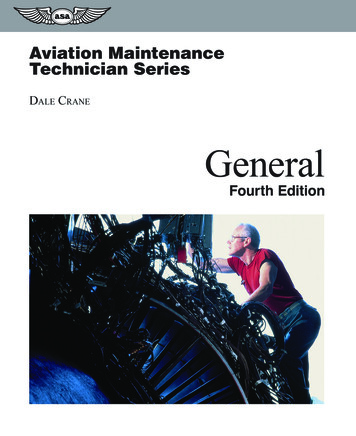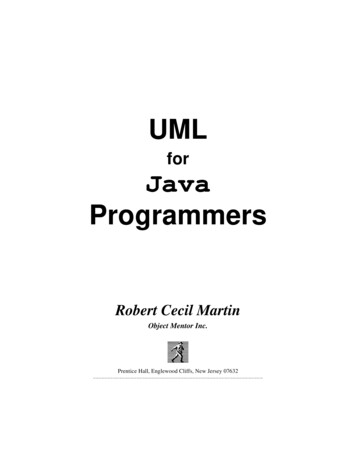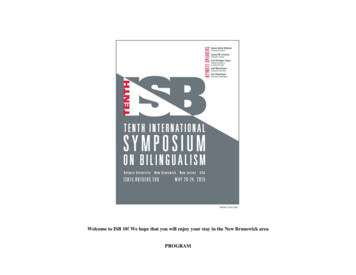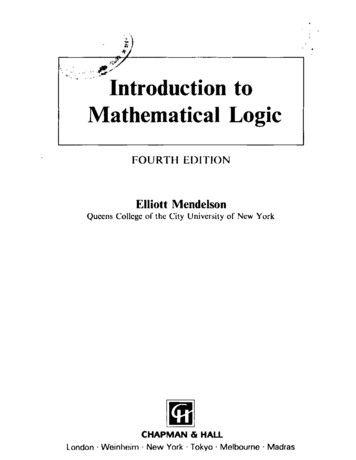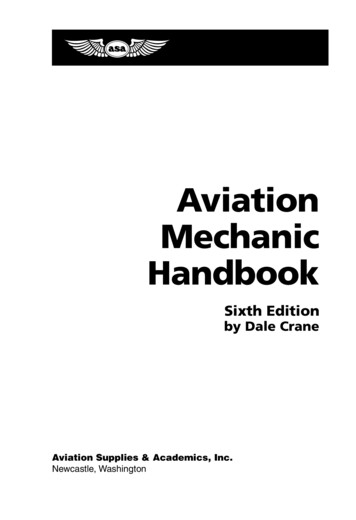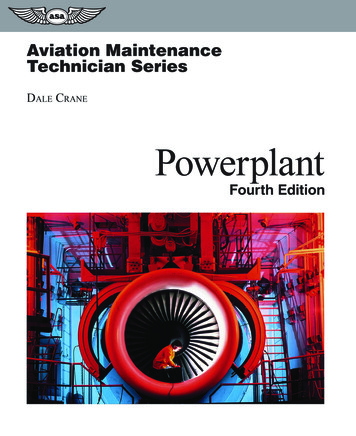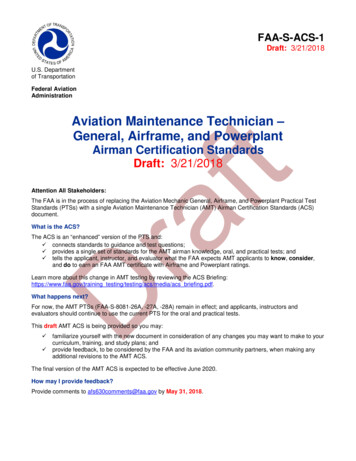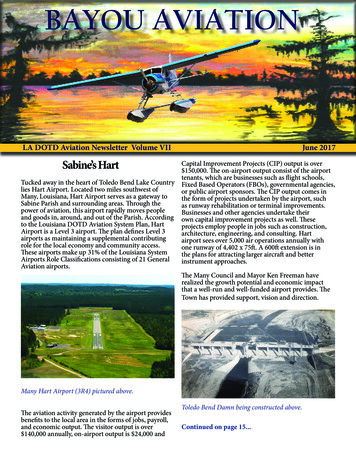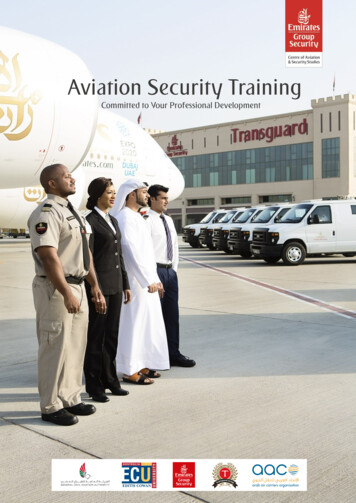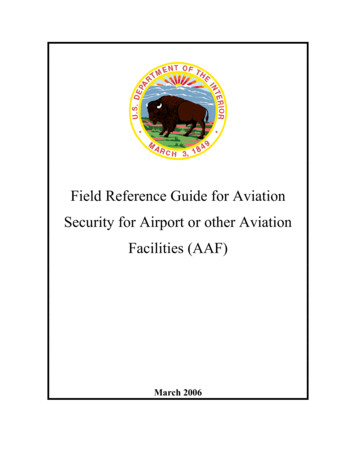
Transcription
Volume 31, No. 2Spring 2013THECanada’s Aviation Hall of FameCanada’s Aviation Hall of FamePanthéon de l’Aviation du rtonDowlingGrossmithCapreolHobbsBaker, eHadfieldDunlapCarrHollick-KenyonBaker, R.F.BradfordGarrattFowler, R.HaltonBellArchibaldHopsonBaker, R.J.BrintnellGilbertFowler, mela1FauquierFraser-HarrisHiscocks
Canada’s Aviation Hall of FamePanthéon de l’Aviation du CanadaCONTACT INFORMATION:Canada’s Aviation Hall of Fame* NEW - PO Box 6090 Wetaskiwin AB* NEW - T9A 2E8Phone: 780.361.1351Fax: 780.361.1239Website: www.cahf.caEmail: cahf@telus.netOFFICE HOURS:Tuesday - Friday: 9 am - 4:30 pmClosed MondaysCAHF DISPLAYS (HANGAR) HOURS:Tuesday to Sunday: 10 am - 5 pmClosed MondaysWinter Hours: 1 pm - 4 pmPlease call to confirm opening times.23Information about The HallChairman’s Message, by Tom Appleton334From Your Editor, by Mary OswaldHappy Birthday to MembersBringing the Global Express to Life, by Laurent Beaudoin56From Stem to Canadarm, by Larry ClarkeMemories - From Whistler to New Zealand, by Robert (Bud) White7-88-910 - 11Exercise Musk Ox, and Tappetti, by Bill CarrReflections of a Spacewalker, by Dave WilliamsThe Canopy Caper, by Robert Bradford11 - 12Operating NAV CANADA, by John Crichton1314 - 151516A Flight to Remember, by N. Byron CavadiasInduction Memories, by Robert (Bud) WhiteMaking a Living as a Northern Pilot, by Vi Milstead WarrenIt All Started with the Order of Icarus, notes by Z. Lewis Leigh17 - 2021Photo Story / History of CAHF, compiled by Mary OswaldQueen Mum Visits Canadian Forces Medical Services, by Wilson Leach22232425 - 262627282930 - 3131 - 32333435Capturing Fame with a Pencil, by Irma CoucillWatch That Prop! by Rex TerpeningTesting the “Beaver”, by Russ BannockSTAFF:Executive Director - Rosella BjornsonAdministrator - Dawn LindgrenActing Curator - Robert PorterBOARD OF DIRECTORS:Tom Appleton, ON, ChairmanJames Morrison, ON, Secretary, TreasurerBarry Marsden, BC, Vice-ChairmanDenis Chagnon, QCWalter Chmela, ONJohn Crichton, ONKenneth Dandy, BCBill Deluce, ONBlain Fowler, ABMiriam Kavanagh, ONJamie McIntyre, QCMike Matthews, BCBill Elliot, Mayor of Wetaskiwin, AB (ex-officio)OPERATIONS COMMITTEE: (Wetaskiwin)Blain Fowler, ChairmanRosella BjornsonJohn ChalmersPerry McPhersonDenny MayMarg MayMary OswaldRobert PorterTHE FLYER COMMITTEE:Mary Oswald, Editor (oswaldm@shaw.ca)780-469-3547John Chalmers, CAHF HistorianJanice Oppen, Design and LayoutPORTRAITS:Irma CoucillPATRON:His Excellency, the Right Honourable DavidJohnston, C.C., C.M.M., C.O.M., C.D., GovernorGeneral of CanadaLanding at Geographic North Pole, by Max WardA Scare Turns Lucky, by Walter ChmelaMy Stikine Adventure, by W. J. (Bill) WheelerEscaping a Downed Bomber, by Ron PeelA Glimpse Into My Specialty Flying, by Barry MarsdenProviding Breathing Equipment for “Very High” Fliers, by Wilson LeachMessage from Mach 25 on ISS, by Chris HadfieldHonouring 'Stocky' Edwards, by Robert (Bud) WhiteA Place for a Lady – Becoming an Airline Pilot, by Rosella Bjornson208 Members, May 1, 20132
Chairman’sMessagefor the cream of our youth. However,long term public interest has sometimeslanguished in the face of competition fromall the modern distractions of today.by Tom AppletonTom AppletonAs I sit down to write this in May, Hall ofFame Member astronaut Chris Hadfield,Commander of Expedition 35 to theInternational Space Station, is wowingCanada and the world with his use of socialmedia from his perch in the universe. Heis bringing day-to-day life aboard the ISS‘down-to-earth’ for millions of school-ageyoungsters and their parents, along withtheir Neanderthal grandparents (that’s meand perhaps some of you!). The space/earth duet, ‘Is Somebody Singing’, thesong Chris and Ed Robertson, of theCanadian rock band the Barenaked Ladies,co-wrote and performed with the WexfordLeeks choir, had already gone viral inCanada when the Commander’s last liveperformance from the ISS was broadcast inearly May.The broad level of public interest in Chris’flight and the reaction from across Canadahas been incredible. It will surely helpinspire new interest amongst the country’syouth in mathematics, engineering andadvanced technical subjects. This is veryimportant today and the world needs moreof it if we’re to continue advancing thehuman race. The contribution made toCanada’s development by innovation inthe aerospace industry has been immenseand is a field with unlimited opportunitiesFrom Your EditorChris’ ability to articulate simplesounding concepts in answer to complextechnical questions, in a way that can beeasily understood by those without muchknowledge of the details, has proven tobe a game changer. He doesn’t speakdown to the common person; he bringsus up to his level. He has single-handedlyraised the level of public interest in space,almost dormant since the space shuttle waswithdrawn from service a few years ago.Through the use of modern communicationtechniques and his passion for music, heis showing the world a new, more humanway to look upon the potential for humanexploration in space. He is presenting thechallenges and opportunities it offers ouryouth. As Canadians, Chris Hadfield ismaking us very proud, indeed.Thank you Commander Hadfield. Keeplighting those fires.We at CAHF wish thefollowingMembersMary OswaldSeveral months ago I approached the ideaof an ‘Anniversary’ issue of The Flyer tocommemorate forty years since Canada’sAviation Hall of Fame was incorporated.Events in Alberta in the early 1970’swere already leading to the formationof an organization, The Order of Icarus,that would recognize the contributions ofaviators across the country and eventuallybecome Canada’s Aviation Hall of Fame.When I asked Members of The Hall tosend me articles for this issue, I reallydidn’t know what to expect. I admit thatI had high hopes that they would respondwith their personal memories, but I mustalso admit that I got more than I expected!Their enthusiasm and generosity, not onlywith their articles, but with photos, isoutstanding, as you can see in these pages.May:Laurent Beaudoin, May 13Les Kerr, May 15Dave Williams, May 16Claude Taylor, May 20Walter Chmela, May 28The Flyer had to expand from its usual twelvepages to include them all, and I am pleasedto say that you can expect to see more ofthese types of stories in the Fall issue.Members of The Hall:This issue is a tribute to you!June:Larry Clarke, June 12Barry Marsden, June 15July:Fern Velleneuve, July 2Rosella Bjornson, July 13Vera Dowling, July 16* Rex Terpening, July 23 (100 years!)August:Nils Christensen, August 15Chris Hadfield, August 29Jerauld Wright, August 31September:Wilson Leach, September 283
Bringing the Global Express to Lifeby Laurent BeaudoinAt Bombardier, we’re always thinking aboutwhat’s next. We constantly seek to createbetter ways to move the world and the daywe stop innovating is the day we might aswell throw in the towel. Back in early 1991when I was CEO, we were busy assessingthe options for our next business aircraft. Wealready had the Challenger, our mid-rangejet, and the Learjet, our smallest one, butwe were thinking bigger, longer and mostluxurious. It was a daunting challenge.When our then-Vice President ofEngineering, John Holding, informed us thatstretching the Challenger was not a viablealternative, I rephrased the problem in thepositive. I said, “Stop telling me what can’tbe done. If you had carte blanche, unlimitedresources and infinite imagination, whatwould you do?”I told John that whatever kind of corporatejet he designed, it had to be a step change notjust an improvement over existing planes.I wanted a business aircraft capable ofmeeting the challenges of the 21st century,which meant non-stop flights between citypairs such as New York-Tokyo and LondonBuenos Aires.John immediately assembled more than 400engineers from ten different countries totackle the exciting challenge of imaginingour first clean-sheet design. This marked aturning point for our company and the birthof the Global Express-a state-of-the art planethat redefined long-range business jet traveland remains the Bombardier achievement ofwhich I am most proud.Of course, being our first clean-sheet plane many more would follow - we were certainlya little nervous. Clean sheets are alwaysa risk; however, based on my own flyingexperience, I knew that range was crucial forexecutive trips. And with the trend towardsglobalization, the need for a business jet withmore range and speed would just increaseover time. What’s more, customers werealready asking for this plane. I was so surethat there was a market for this plane that Idevoted much of my time and energy to itsdevelopment.Global ExpressBusiness Aircraft, 1993Bombardier Inc.Laurent Beaudoin, CEO,Bombardier Inc.1993, Global Express launch year.I must admit though, that when John andhis team estimated the initial costs for theGlobal Express at 1 billion, it temporarilytook the wind out of my sails. At the time,Bombardier just didn’t have the meansto invest 1 billion in R&D. We knew wehad to find another way and that’s exactlywhat we did. We developed aviation’s firstrisk-sharing strategy and invited majorsuppliers to become official programpartners responsible for various parts andcomponents. Now we were a team ralliedaround a common objective while alsosharing the development risks.When we finally started assembling theGlobal Express in late 1993, it was a veryexhilarating time for all of us. We hadhundreds of engineers speaking eightlanguages working in the same room inMirabel outside Montreal. It looked andsounded like a multicultural beehive.4By the time the Global Express entered intoservice five years later, my dream had cometrue. We had succeeded in building a businessjet that leapfrogged over the competition inevery respect. Even a competitor’s offerto repay our Global Express customers’ 250,000 deposits if they switched toGulfstream couldn’t lure them away. Therest, as they say, is history.Laurent Beaudoin, C.C., M.Comm., wasinducted as a member of Canada’s AviationHall of Fame in 1999.
From Stem to Canadarmby Larry ClarkeDuring World War 2 the National ResearchCouncil of Canada (NRC) invented a fistsized device that could extend a tubular tapeinstead of the flat tape within the normalcarpenter’s rule. Unfortunately, except forvery short applications, the tube collapseddue to the pull of gravity on earth, and nowartime use was found. Following the endof the war scientists turned their minds tospace exploration where weightlessnessexisted and the NRC device, now called theSTEM, found many applications as antennaeand as actuators, and the Spar Division ofde Havilland Canada acquired a license todesign, manufacture and sell these products.When I joined de Havilland in 1953, Iassisted the small research and developmentgroup known as the Special Products andApplied Research Division (S.P.A.R.). Atthat time, work was mainly for the Canadiangovernment’s defense applications. Whenthe Avro Arrow was scrapped, SPAR beganto look into non-military and space-relatedapplications. de Havilland was concentratingon its short take-off and landing aircraft anddecided to sell its SPAR Division. I wasfamiliar with SPAR and realized its potentialin the emerging space industry. I gathereda team together and offered to purchase thede Havilland Division and with it the STEMlicense. By the end of 1967 SPAR AerospaceLtd was launched. I served as CEO of SPARuntil I retired in 1990.With the advent of the NASA Shuttle SpaceProgram in the 1950s, the requirementemerged for a space crane to moveequipment in and out of the shuttle whichwould enable the astronauts to conductexperiments in space. The NRC and SPARsubmitted a proposal to NASA for Canadianparticipation. We learned that two majorU.S. Aerospace firms were already studyingthe requirement based on adapting industrialdesigns for production line automated toolchangers. In contrast, SPAR and the NRC,with their experience from using the STEMin space, believed that they could design adevice based on the operation of the humanarm with its multiple joints and flexibilityof movement, and discussed this idea withNASA.NASA photoNASA agreed that if the NRC would funda feasibility study SPAR could competein the competition with the US firms. Toassist in the study, SPAR designed a fullscale simulator complete with a mockup arm. This was a very early example ofengineers using computer aided design andmanufacturing for complex developments,and no doubt led to the extraordinaryreliability of the Canadarm over the past35 years. It also contributed largely to theconfidence within NASA and NRC that thearm approach was the right path to follow,and that Canada should become a full partnerin the Shuttle program.5The great success of the Canadarm has beena source of pride throughout Canada andan encouragement to young Canadians toadd to their pride in Canada’s many otherachievements in the field of aviation. Theselection of Chris Hadfield as the currentcommander of the Space Station is evidenceof the high regard that NASA has forCanadian talent.Larry Clarke, O.C., LL.B., was inductedas a member of Canada’s Aviation Hall ofFame in 1996.
Memories - From Whistler to New Zealandby Robert (Bud) WhiteMy grandson, Matt, reminds me that my‘memories article’ should include skiingand mountain climbing in Whistler andNew Zealand, my 2009 award from the BCAviation Council, and last year s trip acrossthe continent in my Navion. A little ambitiousfor a short article - my Navion story will haveto wait for a later Flyer!I d taken early release from the Air Force in1979 - after 3 years as Base Commander ofCFB North Bay - in order to join NorandaMines as General Manager of their SpecialMetals Division, and later President of theirco-venture NORSAND with Sandvik ofSweden, making seamless tubing for theCanadian and US nuclear power industry.Fascinating stuff, but not flying! So in1983, Lee and I moved West to Vancouver’s‘Canadian Aircraft Products’ (CAP) and theiraircraft manufacturing facility in RichmondBC - which later became AVCORP. Duringthat time, Lee and I were able to hike all overthe North Shore mountains, and I was able todevelop mountaineering skill on ice and rock- culminating in a successful climb of MountWaddington in 1987.That year, I left AVCORP and retired toWhistler to become a ski bum! The next 6years in Whistler - the longest we had everlived in one place - were spent working forInterwest as a ski instructor on Blackcomb/Whistler and learning to ski race in theCanadian and US Masters.Bud White photo‘Bud’ White, ‘Overall’ ski racing Championin New Zealand’s Alpine MastersWhen we first returned from New Zealand in2003, I re-established my flying license andflew Cessna 172s from Boundary Bay withthe Pacific Flying Club. But then, in 2009 Ibegan flying Navion aircraft from Langleyand Abbotsford, and became active with theAir Force Officers Association (AFOA) andthe Battle of Britain Memorial Trust. In 2009,the BC Aviation Council kindly presented mewith their “Lifetime Achievement Award”.Bud White photoRobert ‘Bud’ White, O.M.M., C.D.**,BASc, M.B.A., was inducted as a member ofCanada’s Aviation Hall of Fame at its firstInduction Ceremonies in 1974.‘Bud’ White instructing granddaughterSarah at Whistler, BCIn 1993, Lee suddenly developed a compellingurge to “go see animals in Africa”! Thatled to 10 years abroad - basing ourselves inWanaka, New Zealand - while we travelledto Southern Africa, Australia, China andThailand. We loved New Zealand and mademany wonderful friends there. We were ableto spend the summers hiking and climbing,and I continued to work during winters as aski instructor at Cardrona - and ski race inthe NZ, US and Canadian Masters. In 2001at Queenstown’s Coronet Peak, I won the NZMen Ski Masters’ ‘Overall’ Championship having earlier won the US Masters Downhillat Mammoth Mountain.Bud White photo‘Bud’ and Lee flying into MilfordSound, NZOne special feature of living in New Zealandwas that Lee and I were invited to join asyndicate of high-country Marino sheepranchers who owned a Cessna 172. They werea great bunch, and we were able to fly all overthat very mountainous country, even landingon West Coast beaches. Most memorablewere the flights into Milford Sound andFiordland on the South Island, and aroundthe mountains of Tongariro, Ngauruhoe andRuapehu on the North Island when our sonRick came for a visit.We returned to Vancouver and Canada in2003, and are now comfortably installed ina Yaletown high-rise condo near BC Place.The ski instructing, coaching and racing maybe over, but new skis and boots still keep meskiing actively throughout the BC winters.6Bud White photo‘Bud’ White mountaineering in NZwith son Rick
Exercise Musk Ox, and Tappettiby Bill Carrat Perry River, supposedly on a river of thesame name near its mouth on Queen MaudGulf. This location had been chosen as thepoint where a large para-drop of gasolinein drums would take place, and I was toorganize the local Eskimos to detach thechutes from the drums to prevent the surfacewind from dragging them, with chutes stillattached, cross-country.Of the many experiences of my long militarycareer, one still pops up as if it happened yesterday.It was during ‘Exercise Musk Ox’ which tookplace during the winter months of 1946, involvingthe Canadian Army and the RCAF.The exercise was designed to test equipment,radios, communications, air supply, andpersonnel and their ability to travel andoperate under extreme cold and challengingoperational conditions. It began in the barrengrounds of the sub-arctic regions west ofHudson Bay and north across Queen MaudGulf to Victoria Island, again across theGulf to Coppermine, south across GreatBear Lake and terminating in the heavy bushcountry of Canada’s North West.It was not an easy outing. Snowmobileengines broke down regularly, navigationand communications facilities werearchaic, vehicles often strayed in white-outconditions, military clothing provided poorinsulation against the intense cold, tents wereof poor design for the conditions, gasolineconsumption was double that expected, andthe air supply demands, while met, wentwell beyond the most pessimistic estimatesof requirements.Despite these problems, no serious personnelmorale or physical problems arose, mainlydue to leadership provided by the wellchosen and experienced army experts, andthe dedication of airmen under the directionof W/C Jack Showler.The Army’s equipment for the moving forcewas the Canadian-built snowmobile, a tenton vehicle with an enclosed cabin whichcould accommodate up to five soldiers. TheAir Support Unit was assigned six Dakotaaircraft on wheels and three Norsemanaircraft on skis.On 1 Dec. 1945, I was selected to be oneof the Norseman aircraft trail finding andlogistics pilots. After arriving at Winnipeg,my Norseman was fitted with skis andwinterized. I was issued a new nose tent witha gasoline fueled heater ‘Blow-pot’, nylonwing covers, an emergency survival kit,and down-filled sleeping bag. My survivalTappetti, 1946William Carr collectionclothing was a two-piece padded snow suit, apair of army mitts, a stocking cap and sheepskin lined flying boots.While I did a lot of flying in direct supportof the Moving Force delivering them mail,spare parts and such like support, some flightsposed navigation and safety challenges. Thesharp memory that still pops up is whatbecame a unique trip to Perry River.During a few weeks in February I hadscouted the planned route and on March 5was directed to proceed to the Trading PostEskimo atPerry River, 19467On March 5, I left Baker Lake headed forPerry River, carrying with me Tappetti, anHBC Eskimo employee, just in case I hadtrouble enroute. After a couple of hours Ireached the Arctic Coast in the approximatearea where Perry River was supposed tobe. There was a dotted line on my mapsuggesting the Elice River might be whereI was, supposedly east of Perry River. AsI turned west to coast-crawl to Perry River,I ran into a rapidly developing violent windstorm, a blowing snow white-out withgreatly reduced visibility.The storm gave me no alternative but to land.I touched down on river ice close to shoreand while I tied my aircraft to ice-bridges Icut into the ice, my Eskimo helper quicklybuilt us a small snow house/igloo. I got the‘Red Box’ emergency survival kit, a singleburner primus and our sleeping bags intoour shelter and as an aside, hoped someonesomewhere had heard my radio transmissionsaying I was landing on the coast close towhat I thought was at the mouth of the EliceRiver. The ‘Red Box’ contained very baresustenance for one man for 30 days.(Continued on next page)William Carr collection
Exercise Musk Ox, and Tappettiby Bill CarrTappetti and I quickly settled down in ourlittle snow house, and he of course washungry and wanted to eat. I opened the ‘Box’and doled out a few hard biscuits, someHorlicks tablets and some hard candy andthen closed the box. We melted some iceand made some tea. He was not impressed,and even though our communication witheach other was a sign language exchange,his signs were obvious.We shared the snow house for nearly twodays and it was not a great social occasion.We couldn’t chat with each other because weweren’t very bilingual. Time dragged and hewas not a happy camper. The storm raged,I read and reread the Norseman engineeringorders, the only reading material I had, until Icould almost recite them by heart. He chainsmoked, my carton of cigarettes, but at timeshe insisted on going out into the blowingsnow. He once came back to indicate to methat he had found old raised sled tracks in thesnow, heading west. I got nervous that he toomight ‘head west’ so relented that day andincreased our ration by a few items. Nonethe-less, I still stuffed the ration box intomy sleeping bag when we turned the primusoff at dark. He had kept eyeing that red boxwith ‘hungry’ eyes. I had trouble convincinghim that we couldn’t gobble down the entireemergency ration kit just because we werehungry. His adherence to the Eskimo culturewhere one ate what was at hand and worriedabout the next meal later was obvious.After about thirty-six hours, the storm hadabated and I decided we could start up andhead for Cambridge Bay on Victoria Island.Starting the engine by using the hand crankedinertial fly-wheel system worked and thereliable P&W engine thankfully roared tolife on the first pull of the engagement cable.Once airborne, and heading in a westerlydirection toward Cambridge Bay, I noticeda light flash off-shore on an island. I flewtoward the island and landed at the smallsettlement which turned out to be the PerryRiver Trading Post which was definitelyshown on my map to be located on themainland.On March 11 I sent Tappetti back to BakerLake and went on to Coppermine andeventually Norman Wells. The rest of theexercise was more or less a routine resupplyjob. But the thirty-six hours I spent with myEskimo saviour in that little snow housewhile the storm raged was an experience Iwill never forget.LGen (Ret’d) William Carr, C.M.M., D.F.C.,CD***, BA, BSc, was inducted as a memberof Canada’s Aviation Hall of Fame in 2001.Reflections of a Spacewalkerby Dave WilliamsA dream to explore . . .I have always been an explorer. From anearly age when I watched the original sevenMercury astronauts redefine the limits of ourimagination, I had a dream of exploring the twofinal frontiers - outer space and inner space:an infinite dark void previously the realm ofscience fiction writers, and the brilliant blueundersea world that covers the majority ofour planet. For me, exploration represents arelentless passion to pursue knowledge andit was that passion that fueled my dream ofexploring space.For almost a decade after my first spaceflightin 1998, I had led the Space and Life SciencesDirectorate at Johnson Space Centre, completedtwo missions to the Aquarius undersearesearch laboratory, and gained operationalleadership experience as the Commanderof the NEEMO-9 mission (NASA ExtremeEnvironment Missions Operation), becomingthe first Canadian to live and work in the oceanand in space.On the ISS . . .Now, years later, the dream has come true again.It is August 2007, I am on my second spaceflight, and as a member of the STS-118 crewI will be helping build and service the SpaceStation. I am in the airlock of the InternationalSpace Station with fellow spacewalker, RickMastracchio. We are continuing the assemblyof what is possibly the most complex piece oftechnology in history, ready to exit the airlock tostart the second spacewalk of our careers. Thereis no longer any air pressure in the airlock.mechanism that holds the hatch closed. Thegauge on the hatch reads zero, there is nopressure differential to impede the inwardmovement of the hatch. I brace myself usinga handrail just in case force is required as myright hand pulls the hatch open. It effortlesslyglides through a wide arc engaging a latch tokeep it in the open position.Working in close co-ordination with MissionControl, Rick and I have performed a complexsequence of manoeuvres to equalize the airlockpressure with the vacuum of space. The everpresent hum of the ventilation fan in myspacesuit is a constant reminder of the needfor continuous circulation to remove carbondioxide from the 100% oxygen gas that I ambreathing. With the pressure in my spacesuitequivalent to that of flight level 300, theoxygen is critical to my survival.The panoramic vista of the Earth 350 kilometresaway beckons me and after checking my safetytether, I exit the airlock and attach a temporarytether to the handrail outside. As leadspacewalker I am first out, exiting the airlockheadfirst. Rick, following me, must exit feetfirst and soon we are both in position to closethe airlock thermal cover and start the secondspacewalk of the mission.On Earth, the team in Mission Control verifieswe are ready for hatch opening. The commandcomes as a static-ridden hollow voice soundingdistant in my headset. I respond “in work”,the words are picked up by the microphonesin my helmet and slowly I open the latching8Repairs to ISS . . .The objective of this spacewalk: to removeand replace a faulty gyroscope - one of fourrequired to stabilize the Station’s orbitalattitude. Rick and I move hand-over-hand likerock climbers negotiating a sheer cliff. TheEarth is far below, continuously moving as we(Continued on next page)
travel twenty-five times the speed of sound.Travelling approximately eight kilometresevery second, we orbit the Earth every ninetyminutes seeing a sunrise and sunset every fortyfive minutes. We are so focussed on our tasks,we are surprised to learn we are ahead of thetimeline having taken under an hour to removeand temporarily stow the failed gyroscope.The next phase of the spacewalk is to go to thepayload bay of the docked Space Shuttle andget the new gyroscope and bring it back to theworksite for installation. This will require meto do something only one other Canadian hasdone, ride the Canadarm.Riding the Canadarm . . .Our Shuttle pilot Charlie (Scorch) Hobaughhas manoeuvred the “Arm” into positionby the airlock, enabling me to install a footrestraint on the end effector and climb intoposition for the ride of a lifetime. My safetytether is now attached to this icon of Canadianspace exploration and as I am moved to aposition sixty feet above the Shuttle payloadbay, I cannot help smiling in pride as I seethe Canadian flag on my left shoulder, theCanadian logo on the Shuttle robotic arm,on the Canadian built Orbiter Boom SensorSystem, and on the Space Station Canadarm.The spectacular view of Endeavour against theEarth’s horizon is mesmerizing, an image thatfor me is the equivalent of the Earth rise seenby the Apollo 8 astronauts as they orbited theMoon. I capture the moment with a photographthat will ultimately be used as the cover photofor “Wings in Orbit”, a NASA publicationcelebrating the legacy of the Space Shuttleprogram.In many ways spacewalking is like flying ahigh performance jet, only fingertip forces arerequired to manoeuvre what is, in essence, yourown spacecraft. Three Canadians have had theopportunity to don a spacesuit and perform aspacewalk in the extreme, harsh environmentof space.Somewhere, there is a young Canadiandreaming of being part of an internationalmission beyond the Earth’s orbit, perhapsback to the Moon or on a voyage to Mars. Likethe young boy that dreamed of flying in spaceso many years ago, perhaps his or her dreamwill come true as well.Another dream . . .After a record-setting three spacewalks, mycurrent dream is to see the next generationof space explorers travel farther into space.Dave Williams, C.M., M.D., was inductedas a member of Canada’s Aviation Hall ofFame in 2012.Dave Williams at workin space during his lastspacewalk.NASA photoDave Williamssupported with bootstraps on Canadarmwhile positioning thegyroscopeMy thoughts are interrupted when Scorchasks if I am ready for motion, the sign that itis time to get back to work and bring the new600 kg gyroscope and mounting bracket fromthe payload bay to the Station external storageplatform. The mounting bracket will be lefton the storage platform as the new home forthe failed gyroscope. I grip the handrails ofthe gyroscope trying to estimate how muchstrength will be required to hold onto an objectthat is one-fifth the weight of a Zamboni. Withmicroscopic precision, Scorch positions meabove the storage platform. Rick and I quicklyattach the bracket on the platform, remove thenew gyroscope and I continue on m
lighting those fires. From Your Editor Mary Oswald Several months ago I approached the idea of an ‘Anniversary’ issue of The Flyer to commemorate forty years since Canada’s Aviation Hall of Fame was incorporated. Events in Alberta in the early 1970’s were already leading
